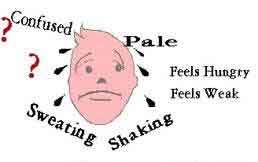Experts Develop Guidelines to Protect Diabetes Patients from Hypoglycemia
Endocrine Society-American Diabetes Association Consensus Statement reflects research advances

In a joint Consensus Statement, The Endocrine Society and the American Diabetes Association broadened the definition of hypoglycemia to include events during which a patient with diabetes experiences symptoms consistent with low blood sugar without a supporting blood test.
Hypoglycemia occurs when patients who have diabetes experience low blood glucose concentrations that put them at risk for injury or death. Acute hypoglycemia can cause confusion, loss of consciousness and seizures.
Endocrine Society member Elizabeth Seaquist, MD, of the University of Minnesota led a group of experts from the two organizations in developing the Consensus Statement. They noted that episodes of hypoglycemia can occur even when test results are not available to confirm the symptoms or a blood test shows glucose levels in the normal range. The Consensus Statement includes classifications for these two events, known as Probable Symptomatic Hypoglycemia and Pseudo-hypoglycemia, respectively. They also emphasized the importance of using hypoglycemic risk as one of the key factors in individualizing a patient’s glycemic target.
Improved understanding of hypoglycemia in patients with type 2 diabetes is, in part, the result of three large clinical trials – Action to Control Cardiovascular Risk in Diabetes (ACCORD), Action in Diabetes and Vascular Disease: Preterax and Diamicron MR Controlled Evaluation (ADVANCE) and Veterans Affairs Diabetes Trial (VADT) – conducted during the past decade. A total of 24,000 people with diabetes participated in the trials.
“Through these clinical trials, researchers discovered that patients who had hypoglycemia were at greater risk for subsequent mortality regardless of whether they were assigned to the intensive or standard therapy group”, said Endocrine Society Past-President and Consensus Statement co-author Robert A. Vigersky, MD. “Whether a person has type 1 or type 2 diabetes, it is crucial to minimize the number of hypoglycemic episodes because patients gradually become desensitized to the symptoms, become less likely to recognize and address hypoglycemia, and thereby have a greater risk of confusion, loss of consciousness, seizure, coma and death.”
The Consensus Statement incorporates research findings that have emerged since The Endocrine Society’s 2009 “Evolution & Management of Adult Hypoglycemic Disorders” Clinical Practice Guidelines and the American Diabetes Association’s 2005 report on hypoglycemia were issued. In the intervening time, researchers have found that older adults who have type 2 diabetes, children with type 1 diabetes and hospitalized patients with diabetes are particularly vulnerable to hypoglycemia.
“We recognize that patient education and health care provider surveillance plays a key role in averting hypoglycemic episodes,” Vigersky said. “The Consensus Statement provides new informational resources for both patients and health care providers, including a patient hypoglycemia questionnaire, a provider checklist and a table listing key strategies for restoring the patient’s awareness during a hypoglycemic episode.”
The Consensus Statement, “Hypoglycemia and Diabetes: A Report of a Workgroup of the American Diabetes Association and The Endocrine Society,” will appear in the May 2013 issue of The Journal of Clinical Endocrinology and Metabolism.
Source Newsroom: Endocrine Society

